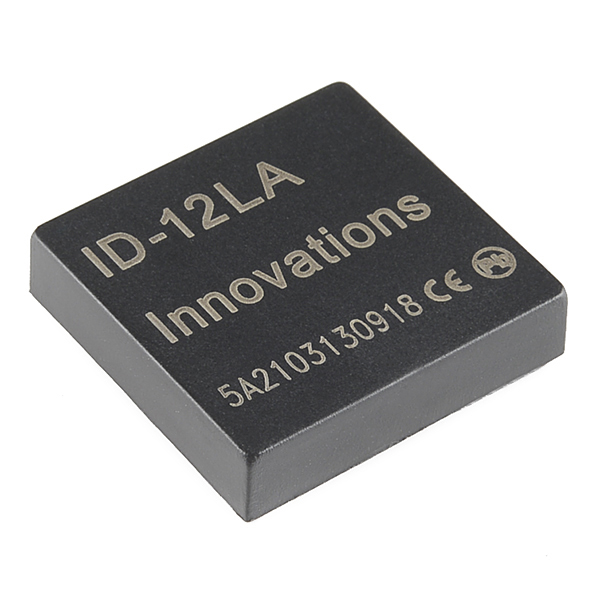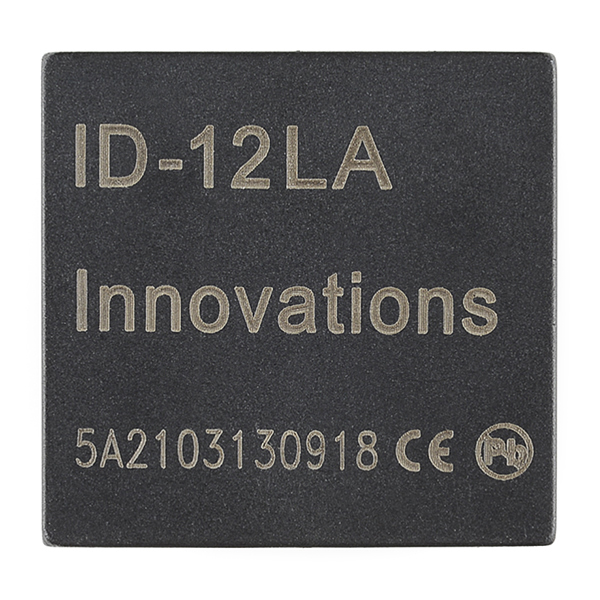RFID (radio-frequency identification) is the wireless non-contact use of radio-frequency electromagnetic fields, for the purposes of identifying and tracking tags attached to objects. This is the ID-12LA, a very simple to use RFID reader module from ID Innovations. With a built in antenna, the only holdup is the 2mm pin spacing. Power the module, hold up a 125kHz card, and get a serial string output containing the unique ID of the card.
Note: The new ID-12LA is essentially the same as the ID-12, but has a lower voltage input.
- 2.8 - 5V supply
- 125kHz read frequency
- EM4001 64-bit RFID tag compatible
- 9600bps TTL and RS232 output
- Magnetic stripe emulation output
- 120mm read range
- 25x26mm
RFID Reader ID-12LA (125 kHz) Product Help and Resources
SparkFun RFID Starter Kit Hookup Guide
May 5, 2015
Learn the basics of how to get started with the SparkFun RFID Starter Kit.
SparkFun Qwiic RFID-IDXXLA Hookup Guide
March 14, 2019
The Qwiic RFID ID-XXLA is an I2C solution that pairs with the ID-LA modules: ID-3LA, the ID-12LA, or the ID-20LA, and utilizes 125kHz RFID chips. Let's take a look at the hardware used for this tutorial.
Build a Qwiic Jukebox that is Toddler Approved!
March 29, 2019
Follow this tutorial to build your own custom jukebox. Note, this is designed simple and tough for use primarily with toddlers. It's also a great introduction to SparkFun's Qwiic products!
Core Skill: Programming
If a board needs code or communicates somehow, you're going to need to know how to program or interface with it. The programming skill is all about communication and code.
Skill Level: Rookie - You will need a better fundamental understand of what code is, and how it works. You will be using beginner-level software and development tools like Arduino. You will be dealing directly with code, but numerous examples and libraries are available. Sensors or shields will communicate with serial or TTL.
See all skill levels
Core Skill: Electrical Prototyping
If it requires power, you need to know how much, what all the pins do, and how to hook it up. You may need to reference datasheets, schematics, and know the ins and outs of electronics.
Skill Level: Competent - You will be required to reference a datasheet or schematic to know how to use a component. Your knowledge of a datasheet will only require basic features like power requirements, pinouts, or communications type. Also, you may need a power supply that?s greater than 12V or more than 1A worth of current.
See all skill levels
Comments
Looking for answers to technical questions?
We welcome your comments and suggestions below. However, if you are looking for solutions to technical questions please see our Technical Assistance page.
Customer Reviews
4.4 out of 5
Based on 13 ratings:
2 of 2 found this helpful:
Great 125 KHz EM4100 Reader streamlines model railroad operations!
I use ID-12LAs as part of my model railroad to track rolling stock as it leaves and enters yards. The ID-12LA plays an integral part in generating "Wheel Reports" that are used by Yard Masters to route cars during "Operating Sessions" which simulate the operations of real railroads. We've found the ID-12LA to have the optimum range for reliably reading "kitty tags" on the bottoms of railroad cars without getting false reads from cars on adjacent tracks. Also the ID-12LAs can placed as close as 6" from one another without interference which is great for busy yards with multiple throats.
We've even offered the RFID system to other model railroaders using the ID-12LA from Sparkfun: visit us at http://www.modelrailroadcontrolsystems.com/radio-frequency-identification/ for more information!
Sparkfun provides great support and carries all the handy bits you need to make your project come to life!
2 of 3 found this helpful:
Cool product
Does not read any RFID card, only those that match the frequency. Also, not shown in the specs or hookup guide, I had to use a 4.7 kohm pullup resistor between 5V and pin 9 on the sensor, or I'd just read "FFFFFFFFFFFF"
You are correct, these are limited to the 125kHz cards.
Easy to set up, fun to play with!
For simple projects, this is easy to set up. Aside from the 2mm pin spacing, at the bare minimum all you need is voltage, ground, and the UART receiving line. Couldn't be simpler! From there, you've got the power of RFID. You're only limited by your imagination!
Excellent RFID reader - recommended!
The ID-12LA is a nice RFID tag reader that is reliable, simple to use and works out-of-the-box. Nothing tricky to the set up and it is easy to interface to a microcontroller or a PC serial port. Works well with small 'button' RFID tags as well as 'credit card' size ones.
This is a good module, and I will be looking for more stuff from the company that makes these.
Great RFID reader
Nice, very reliable and "not too strong" to let multiple reader be used next to each others, at the end, a quite perfect product!
RFID ID-12LA and Buttons
All got here (Europe) on time and works just fine. Thanks!
Easy to use and works well
I recently did a project for a client where I tested quite a few RFID readers, and we settled on a no-name brand that could take a custom antenna to increase the range. The ID-12LA beats that reader hands down! The range is fantastic for the size and if you need an external antenna there the ID-3LA will work. The serial output is easy to parse. My only complaint would be that the adaptor does not come with the headers wich adds $2 to the cost. If the pin spacing was 2.54mm I would give 5 stars. At ~$30 this is not cheap, but it does the job well.
Works great
Bought reader to be used with I2c reader board. The combination works great. A note about the I2c reader board. It comes set to address 0x7d. This address works but it can’t be seen the i2cdetect app. The apps high address limit is 0x77. In reading the docs for the reader board I learned the address of the board can be set via software to another address. I changed mine to 0x77.
Couple Of Bugs
So I got this product for an RFID experiment. I used the 125kHz button to accompany this reader. Unfortunately this reader could only sense the button at a distance of about an inch. This was a much smaller distance than expected. While using a piezobuzzer in my Arduino circuit, the buzzer signals were interfering with the reader to make it unable to detect the button. This product is not for it's price.
Sorry you're having trouble! The issue you're seeing with a piezo buzzer is likely something in your code as a buzzer wouldn't interfere with the reader directly. For your range issue, about an inch is the expected read range for the small button RFID tag as can be seen in the video above. If you have further issues, please contact our technical assistance team to see if they can help.
Works exactly as I expected to read the small glass chips I will be useing.
Used these with a dual reader shield attached to a Arduino uno to read chips attached to HO train cars. Highly recommend the extra break out board to attach them to the reader shield. Found out I can use a few more since the rest of the hardware I already have will support 8 reader chips instead of the original 4 I had planned for.
RFID chip reader
Everything works great. Only issue is ID-12LA has a very close tolerance to read a chip.
Excellent product
The RFID worked like champ. I was disappointed that the breakout board did not come with the product.





Hi, Is it possible to connect this reader ID12LA directly to an esp32 board without using the qwiic board ? I tried but it seems not possible without the Sparkfun Qwiic board. Any idea or schematic or ressources ? Thanks in advance for your help and answers
How can we get RSSI value for the scanned tag?
I am pretty sure that isn't a feature of the RFID reader.
Sorry if this is obvious. Does this or any other RFID reader also write to RFID cards as well?
Most RFID devices can only read cards. If you're looking at a reader that can also write, the description would say something about having the capability to write to a card.
This particular module is read only, but there are other modules that can read and write RFID cards.
Comparison with SEN-11828 would be welcome. That offers 180mm read distance, and is larger, and $5 more were what I spotted. Oh... and maybe add the other to the "similar items" list?
Is this part still being manufactured? I tried emailing the manufacturer a week ago with no answer and when I tried calling them I get "this number is disconnected". I was hoping to get one to use in a product I'm creating but need to know I can get spares in future...
We have no reason to believe it is being discontinued. It looks like we received an order from them last month. If you have questions on this unit feel free to email our techsupport department and they can help you out or hopefully get you in touch with the manufacture.
How can i reduce tag distance (sensitivity) ? (its to much for my application)
Does anyone know any module that can read HID cards? We want a 1-Wire RFID Reader that supports all HID cards as well.
I just uploaded the kicad symbol and footprint for kicad to kicadcloud.com
Is the only difference between this product and "RFID Reader ID-20LA (125 kHz) SEN-11828" the read range?
Can this chip be hot air reflow soldered to pcb's? In the documentation they do not mention safe temperature range.
Does animal tag reads FDX-B?
If anybody is looking to connect this to a Raspberry Pi it's pretty easy. Use one of the 5V pins from the header to power it, along with ground and then just connect the TX pin of the rfid module to the RX pin on the Pi header. I've created a Python module that makes interfacing with the reader quite simple.
The breakout board is retired? I'm having difficulty finding an alternative. Is there one?
contact me. If I find some spare time (which I should be able to) I could design you one. You'd have to etch it out and everything yourself, but that should be easy given a little internet tutorial :)
I purchased it two months ago https://www.sparkfun.com/products/retired/8423 guess I better be careful with it now. Check the new product page, maybe its coming friday. I dont want to spoil the surprise: I'll wait a day
I wonder, did they discontinue the breakout board in favor of the RFID USB reader (SEN-09963)?
Did I miss it? I'm not seeing it :(
Nope, wasnt released. Gotta wait until next week hopefully.
HI, this reader supports 125khz EM4100 64bit tag RFID?
Hi, that is so compatible with arduino uno and visual studio? any tutorial you refer me?
How about putting this on a PCB with FTDI FT312 so that Android users can access it directly?
The reader transmits six '255'.
Once in a blue moon I can get it to actually transmit an actual ID, eg. 2364630303543433238313730DA3.
I'm certain the wiring is fine. 3.3 v to Vcc on pin 11 and GND to pin 1.The tx pin (9) is hooked up to one of the uart ports on a teensy.
How can I get the reader to ALWAYS transmit a proper tag ID instead of a bunch of nothing?